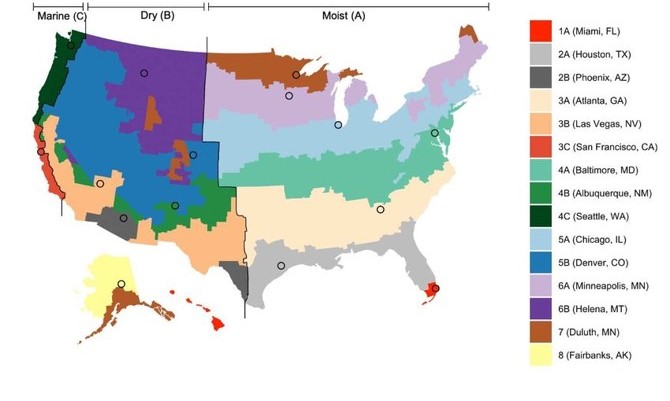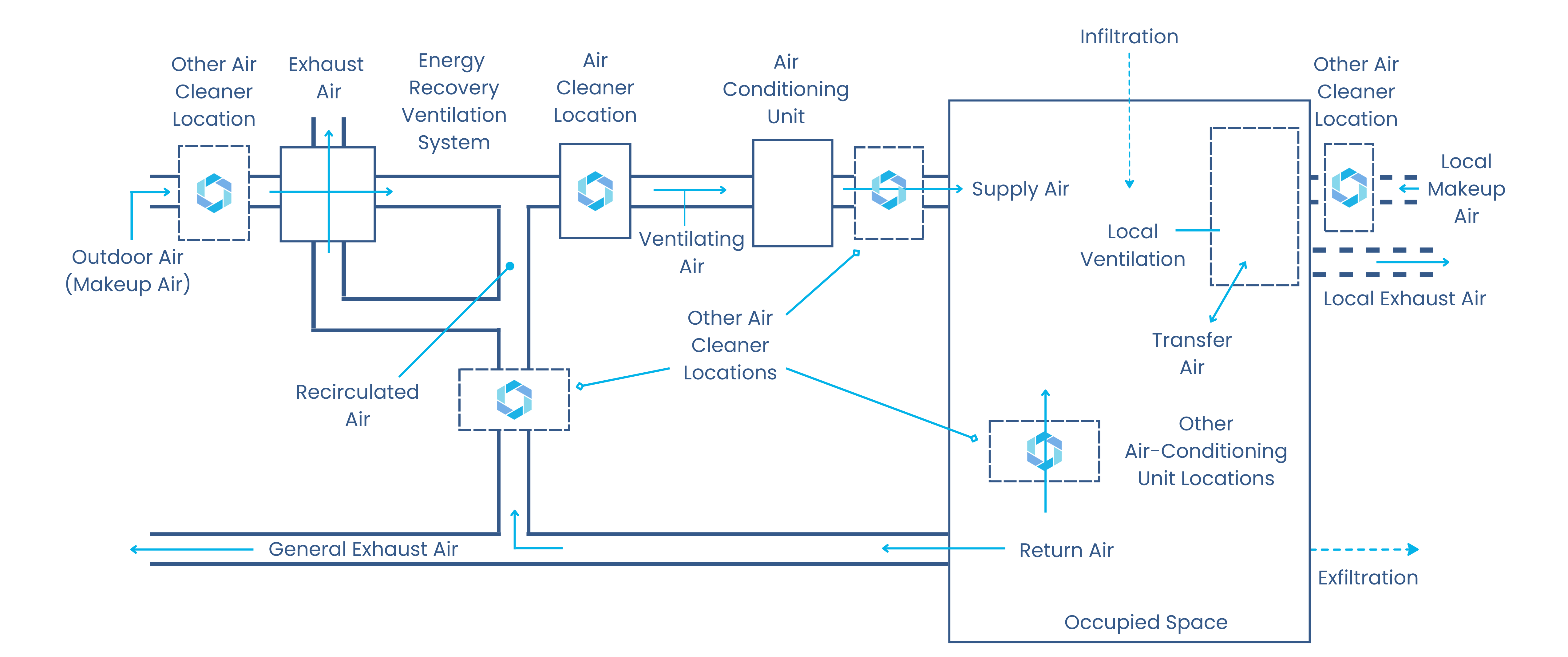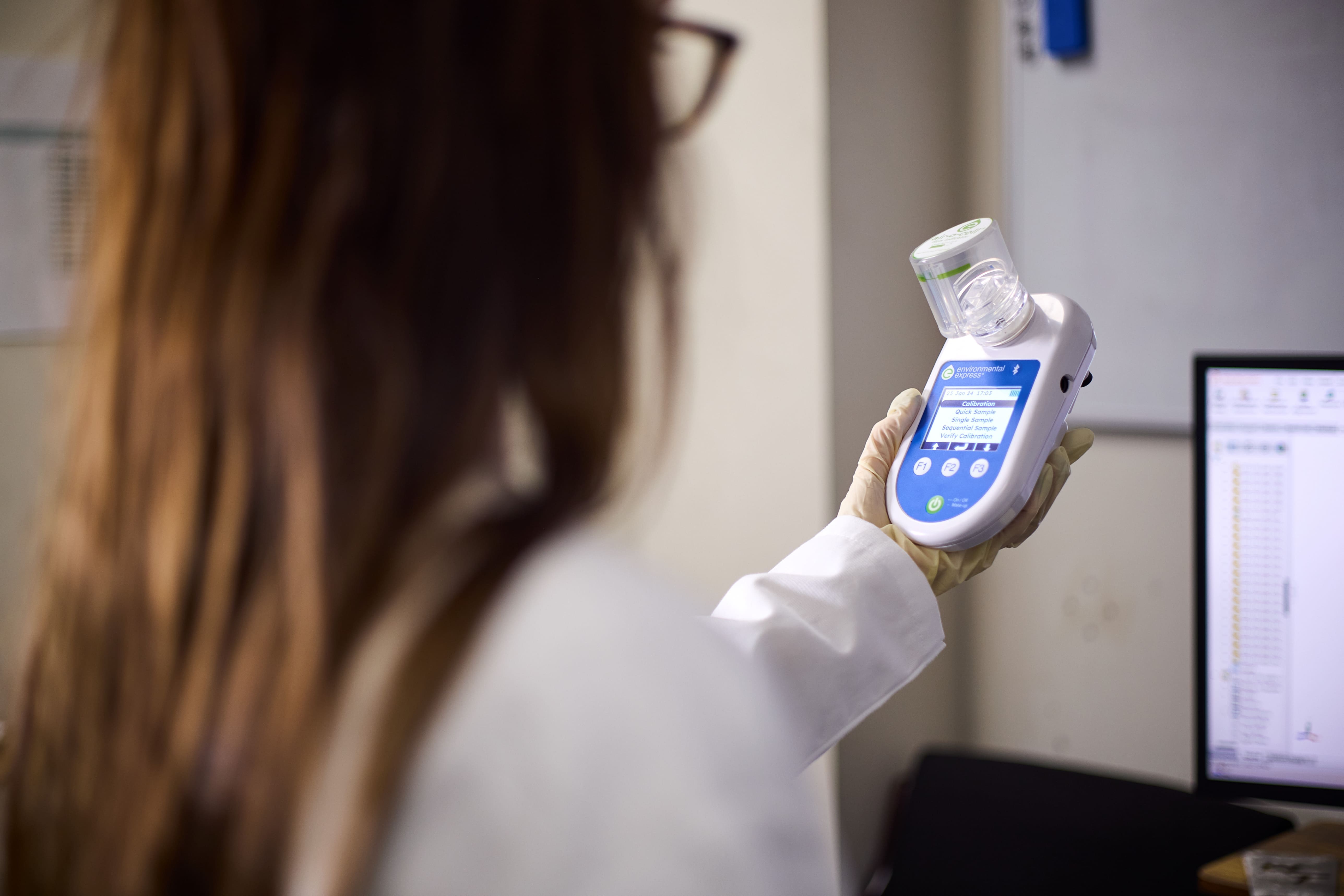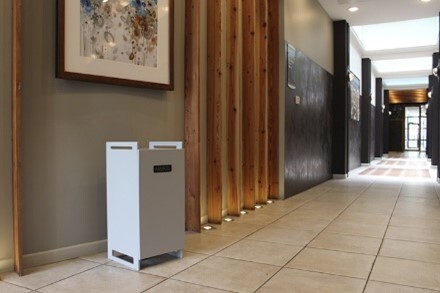The Indoor Air
Quality Procedure
The Indoor Air Quality Procedure revolutionizes ventilation design by enabling energy efficiency and promoting safer indoor environments.
What is the Indoor Air Quality Procedure?
The Indoor Air Quality Procedure (IAQP) is an alternative to the widely used Ventilation Rate Procedure (VRP) for determining the design rate of outdoor airflow necessary to maintain acceptable indoor air quality. Specifically, this energy efficient design ensures that concentrations of design compounds such as formaldehyde, PM2.5, and ozone, in the indoor environment are kept below their design limits, as specified in Table 6-5 of ASHRAE Standard 62.1-2022. Low concentrations are achieved through a combination of source control and the purification of recirculated air.

Key Benefits
Health and Safety
Identifying and eliminating harmful contaminants in indoor air reduces the risk of health problems for building occupants, thus creating a safer and healthier indoor environment.
Energy Savings
Effectively reduce the intake and conditioning of polluted Outside Air (OA) by 50%-80%.
Lower Costs
Reduced ventilation allows for a reduction in HVAC equipment capacity and lower operational costs.
Liability Mitigation
The reduction in pollutants and health risks minimizes potential legal financial liabilities.
Compliance
Maintains compliance with ASHRAE Standard 62.1-2022 and supports ASHRAE Standard 241 and qualification for LEED credits.
IAQP Made Easy
How to Implement
IAQP offers the flexibility to apply in both new construction projects and existing buildings. Whether as a design strategy in plan/spec or a retro-fit solution, IAQP delivers results.
Retro-Fit
Converting an existing facility to IAQP allows for an immense reduction in ventilation energy use and operational costs. At the same time, it requires less maintenance on HVAC equipment while improving occupant health with targeted contamination.
Plan/Spec
Implementing IAQP in new construction design allows downsizing HVAC equipment, such as RTUs, AHUs, DOAS, chillers, boilers, etc., and can often times eliminate the need for ERVs, significantly savings on capital costs.
Ventilation Methods Comparison

ASHRAE Table 6-5
ASHRAE Table 6-5 is a critical component of the Indoor Air Quality Procedure. Specifically, this table identifies contaminants of concern that must remain below design limits when designing ventilation under IAQP, instead of relying on the prescriptive Ventilation Rate Procedure. Additionally, it provides benchmark concentration limits based on health and source criteria, offering clear targets for air cleaning and filtration performance. In this way, ASHRAE Table 6-5 serves as the foundation for clean and healthy indoor environments, enabling more precise, efficient, and health-focused building designs.
| Compound | Cognizant Authority | Design Limit |
| Acetaldehyde | Cal EPA CREL (June 2015) | 140 µg/m³ |
| Acetone | AgBB LCI | 1200 µg/m³ |
| Benzene | Cal EPA CREL (June 2015) | 3 µg/m³ |
| Dichloromethane | Cal EPA CREL (June 2015) | 400 µg/m³ |
| Formaldehyde | Cal EPA 8-hour CREL (2004) | 33 µg/m³ |
| Naphthalene | Cal EPA CREL (June 2015) | 9 µg/m³ |
| Phenol | AgBB LCI | 70 µg/m³ |
| Tetrachloroethylene | Cal EPA CREL (June 2015) | 35 µg/m³ |
| Toluene | Cal EPA CREL (June 2015) | 300 µg/m³ |
| Xylene, total | AgBB LCI | 500 µg/m³ |
| Carbon monoxide | U.S. EPA NAAQS | 9 ppm |
| Particulate matter (PM2.5) | U.S. EPA NAAQS (annual mean) | 9 µg/m³ |
| Ozone | U.S. EPA NAAQS | 70 ppb |
| Ammonia | Cal EPA CREL (June 2015) | 200 µg/m³ |
Climate Zones in the IAQP
Heating, cooling, and dehumidifying outdoor air can be costly depending on your climate zone.

Air Cleaning in the IAQP
Adding air cleaners to ventilation design allows for energy reduction through
recirculated and purified air, thus reducing the intake of outdoor air while maintaining all
design compounds within the building under their design limits.

IAQ Verification Testing
Verification testing is a critical step in the Indoor Air Quality Procedure that ensures a building’s ventilation and air cleaning systems are effectively controlling contaminants of concern. After system installation and normal operation begins, air sampling is conducted to confirm that indoor concentrations of the pollutants listed in ASHRAE Table 6-5 are within the acceptable limits defined by the standard. Compliant verification provides documented proof that the design meets performance-based IAQ goals, offering accountability, compliance assurance, and a higher level of protection for occupant health. Furthermore, it supports energy-efficient strategies by validating that reduced outdoor air volumes, paired with advanced filtration, still achieve clean indoor air.
IAQ Verification Requirements
Allowed Laboratory Test Methods for the IAQP Verification Testing
| Compound | Allowed Test Methods |
| VOCs except formaldehyde, acetaldehyde, and acetone | ISO 16000-6; EPA IP-1; EPA TO-17; ISO 16017-1; ISO 16017-2; ASTM D6345-10 |
| Formaldehyde | ISO 16000-3; EPA TO-11; EPA IP-6; ASTM D5197 or testing method that is compliant with the California Air Resources Board’s (CARB) § 93120 |
| Acetaldehyde and acetone | ISO 16000-3; EPA TO-11; EPA IP-6; ASTM D5197 |
| Carbon monoxide | ISO 4224; EPA IP-3 |
Direct Reading Instruments Minimum Specifications for the IAQP Verification Testing
| Ozone | PM2.5 | Carbon Monoxide | Formaldehyde | |
| Accuracy (±) | 5 ppb | Greater of 5 µg/m³ or 20% of reading | Greater of 3 ppm or 20% of reading | 0.1 ppm |
| Resolution (±) | 1 ppb | 5 µg/m³ | 1 ppm | 2% full scale with calibrated linearity range |
Number of Measurement Points for the IAQP Verification Testing
| Total Occupied Floor Area, ft² (m²) | Number of Measurements |
| ≤25,000 (2500) | 1 |
| >25,000 (2500) and ≤50,000 (5000) | 2 |
| >50,000 (5000) and ≤100,000 (10,000) | 4 |
| >100,000 (10,000) | 6 |
The ASHRAE IAQP Calculator
The IAQP calculator is a comprehensive tool developed by ASHRAE. Designed to be user-friendly, the calculator allows architects, engineers, and building owners to:
Assess IAQ Impact of Design Features
Evaluate how building design factors, such as occupancy, ventilation rates, filtration, air cleaning technologies, and material emissions, affect indoor air quality.
Optimize IAQ Solutions with Data-Driven Insights
Use calculated IAQ metrics to guide the selection of efficient ventilation and air cleaning strategies that minimize outdoor air requirements while maintaining healthy indoor air.
Achieve ASHRAE Standard 62.1 and 241
Compliance With AirBox Air Cleaners
AirBox air cleaners are specifically engineered to abide by the strict indoor air quality requirements set forth by both ASHRAE Standard 241 for heightened infectious risk and ASHRAE Standard 62.1-2022 Indoor Air Quality Procedure for standard operation.
By harnessing advanced air purification technologies, AirBox systems effectively capture over 99.99% of tested airborne contaminants,
including infectious aerosols that can pose significant health risks. Tests are available on request.
Our air cleaners apply to a wide range of building types, including corporate offices, construction sites, schools, and healthcare facilities.
AirBox Maintains Compliance

Professional Analysis
Our data-driven IAQ Testing takes the guesswork out of what’s going on with your air. It tells you exactly what contaminants are in your indoor air and how much. These steps will lead you from guessing to knowing – and from dirty, unhealthy air to clean.

Asset Protection
By ensuring good indoor air quality, the HVAC system can operate more efficiently, reducing energy costs and extending its lifespan. This, in turn, can also lower the maintenance costs for your building.

Risk and Liability Mitigation
Building owners and managers have a legal responsibility to provide a safe and healthy environment for their occupants. Failure to maintain proper IAQ can result in serious liability risks, including lawsuits, fines, and damage to the reputation of the building.
Ready to implement to the IAQP and save energy?
Partnering with a trusted name like AirBox ensures that you’re not only compliant with
ASHRAE Standards, but also providing the best environment for your occupants.

